Get straight to the point with our easy-to-use guide on how to turn fractions into decimals.

Author
Christina Levandowski

Expert Reviewer
Jill Padfield
Published: January 18, 2024


Get straight to the point with our easy-to-use guide on how to turn fractions into decimals.


Expert Reviewer
Jill Padfield
Published: January 18, 2024




Get straight to the point with our easy-to-use guide on how to turn fractions into decimals.

Author
Christina Levandowski

Expert Reviewer
Jill Padfield
Published: January 18, 2024


Key takeaways
Does your heart sink when the teacher tells you to leave your answer in decimal form? Don’t worry! Converting fractions to decimals doesn’t have to be a scary process. In fact, as you get older, it might be even easier than trying to figure out fractions.
Today, we’re going to help you convert fractions to decimals with confidence. Let’s dive in.
Have you ever seen signs at the store that say something like “get 50% off” or “25% off after your first purchase”? Your parent or guardian gets all excited because they know they get to save money, and you might get more clothes or toys!
It’s important to know how to convert fractions into decimals so you can understand what these percentages really mean. If you know that 50% equals ½, then that means you can say to mum or dad, “Hey, since the sign says everything is 50% off today, can I get two toys instead of one?”
Or maybe you’re trying to figure out what your grade will be on a report card. Grades are usually calculated as percentages, like 75% or 100%. But, let’s say your teacher tells you that, on one of your spelling tests, you got 14/16 of the questions right. Well, what does that mean?!?
Once you figure out how to convert fractions to decimals, you’ll be able to answer that question in seconds.
So what are we waiting for? Let’s start learning!
The best part about converting fractions to decimals? There are plenty of ways to do it!
We’ll walk you through some of the best methods below. Pick your favourite method to use, then absolutely ace your next maths test!
Did you know? You can actually use long division to get your conversion done — in fact, you can look at a fraction as a division problem!
There are a few key steps you need to follow in order to convert a fraction into a decimal using division. Keep in mind that you can add as many 0’s as you need behind a whole number to help solve your division problem.
EXAMPLE: Convert 4/15 into decimal form.
1. Identify your numerator and denominator – Remember, the numerator is the number on the top of a fraction and the denominator is the number on the bottom. Here, our numerator is 4 and our denominator is 15.
2. Write the fraction as a division problem – Place the 15 outside the division bracket, and place 4 inside the bracket. Then ask: “How many times can 15 go into 4?”
3. The answer is “no times,” so we have to make 4 bigger than or equal to 15 – Add a 0 behind the 44, giving us 15 ⟌40.
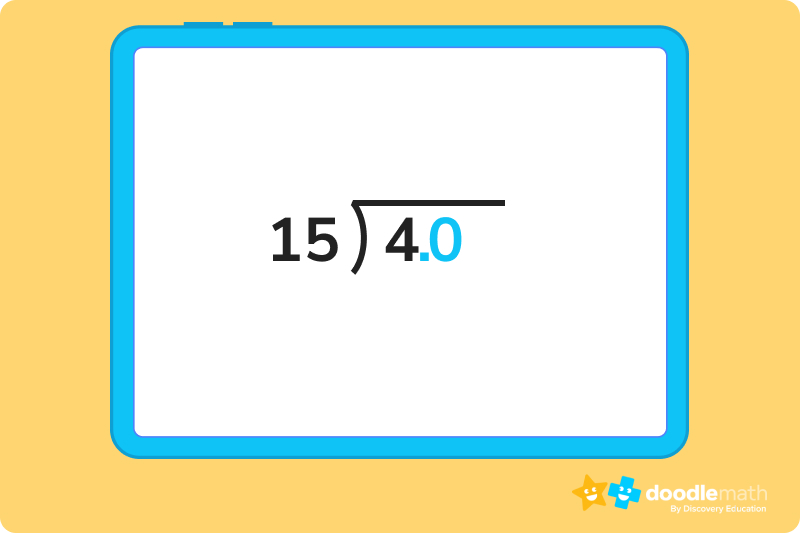
Keep in mind that this is really 4.0, with the decimal point between the 4 and the 0, but to divide, you can think about it as the number 40. Just remember that the answer will be placed in the tenths place of the quotient as the first digit of your decimal answer (this will make more sense below!)
4. Now, we have to determine how many times 15 can go into 40 – Since we can do this twice, our quotient is 2.
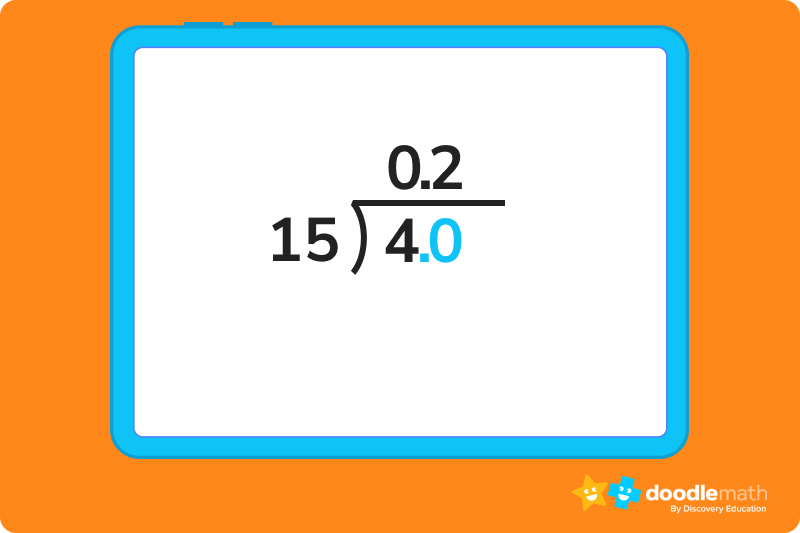
5. Start the long division process – We multiply 15 by 2 and get 30. Place the 30 beneath the 40, then subtract. You should get an answer of 10.
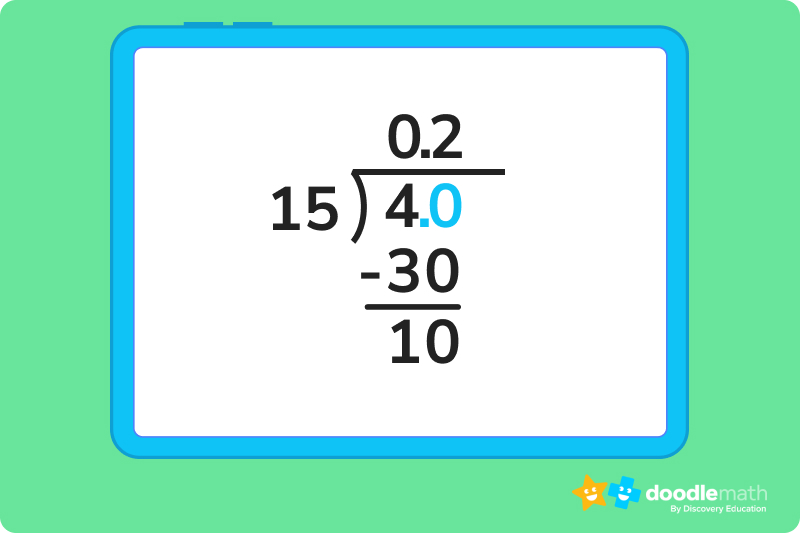
6. Since 10 is smaller than 15, we can add another 0 behind the decimal in our dividend – That way, we can keep dividing with a larger number to make it a little bit easier.
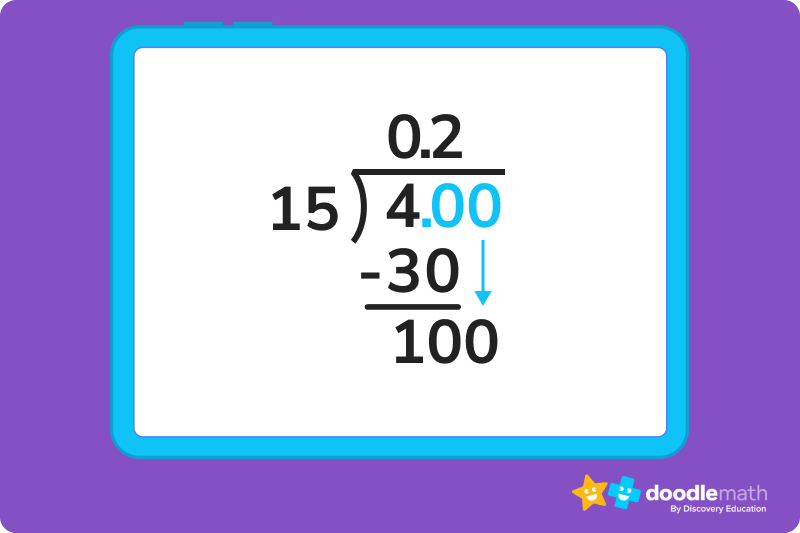
7. Solve the revised problem of 15⟌100 – 15 goes into 100 six times, giving us a quotient of 6 and a remainder of 10 after we finish our division operation. Our quotient, at this point, should look like 0.26 — and our equation is back to 15/10.
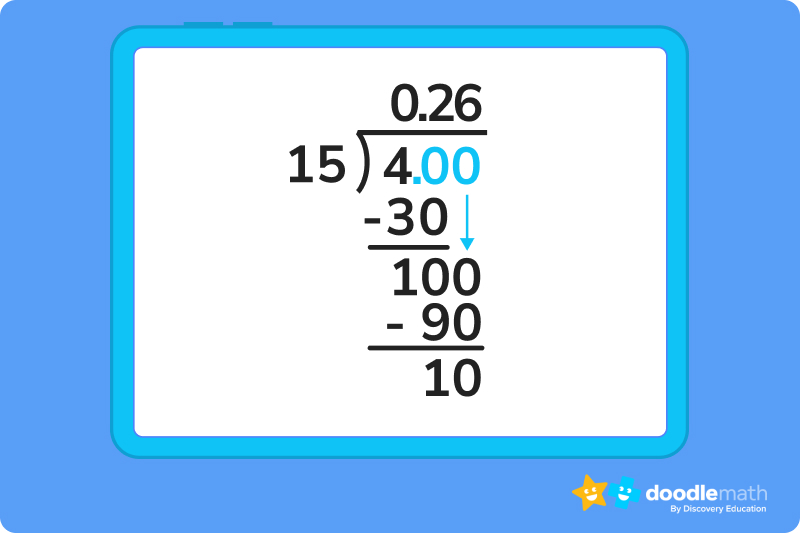
8. Continue the process and notice – If you keep going, you will notice that we keep dividing into 10, adding a 0 to divide into 100, getting a quotient of 6, and then having yet another remainder of 10.
This value is going to be a “repeated value,” meaning no matter how many times we drop a 0 down and complete the division process, we will always have a remainder of 10. We note the answer as 0.2666666666 or with a figure called a “vinculum” above the 6, which indicates a repeated value. This looks like:

To change a fraction into a decimal, you can also change your denominator using the powers of 10.
Why do this, you ask? Well, it’s an easier way to change your number to decimal form.. For example: A value of 9/10 can be understood as 0.9 and a value of 45/100 can be understood as 0.45 — which are easier to work with.
Let’s see this in action below!
EXAMPLE: 2/5
Unlock unlimited maths questions
Put your skills to the test with fun exercises + maths games that are proven to boost ability!
Try DoodleMaths for free!
Select a year group
Now that you know how to convert fractions to decimals, it’s time to take a look at some common conversions you can memorise. Knowing these common conversions makes your maths homework so much easier — which is why we’ve put this handy table together for you to look at any time you need it.
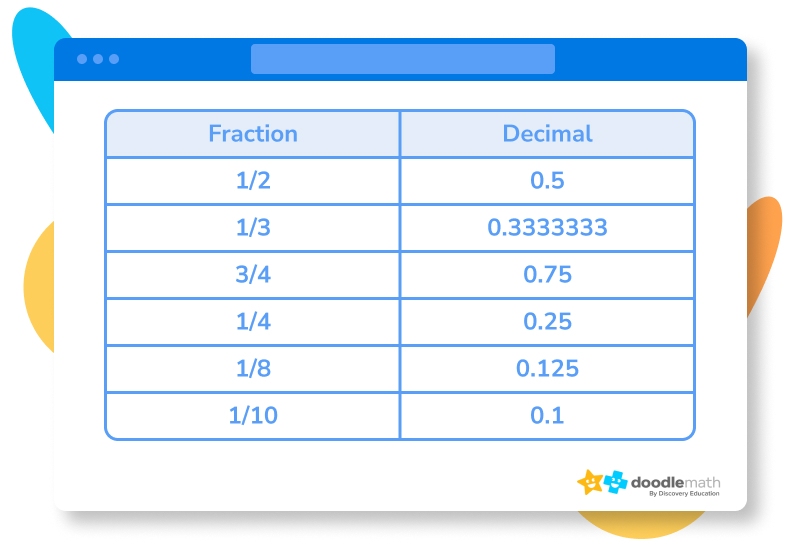
1. Convert ⅗ using the long division method
3/5 (via long division method)
2. Convert 4/10 to a decimal using the power of 10s method
4/10 (via power of 10’s method)
3. Convert 4/25 to a decimal using the long division method
4. Convert 2/7 to a decimal using the long division method
Ready to give it a go?
Ready to do it on your own? We’re sure you’ll knock it out of the park! Don’t be afraid to mess up and get back up after…it’s all part of the learning process.
Speaking of the learning process, the only way to keep going is to — wait for it — practise! We’ve put together a few more problems to help you master the art of converting fractions to decimals.
We know you’re going to ace your next maths test after you perfect this maths superpower!
Want to learn more about fractions? DoodleMaths is an award-winning app that’s filled with thousands of questions and games exploring multiplication, division and more!
Designed by teachers, it creates each child a unique work programme tailored to their needs, doubling their progression with just 10 minutes of use a day. Try it for free!


0.2
How did we get here?
0.4
How did we get here?
0.25
How did we get here?
0.75
How did we get here?
0.5
How did we get here?
While a calculator can be handy, you do not need one to properly convert fractions to decimals. In fact, it’s often better to learn without one so you have the maths skills mastered going forward.
Often, you’ll find that the easiest way to convert quickly is to use a calculator or pen and paper to divide the numerator by the denominator.
1/16 in decimal is 0.0625.
A decimal point indicates fractional numerical elements that are not whole numbers. They are listed to the right of the decimal point, in the respective tenths, hundredths, and thousandths places (and so on).


Parents, sign up for a DoodleMaths subscription and see your child become a maths wizard!

Lesson credits

Christina Levandowski
Christina has written for hundreds of clients. She has extensive experience working with marketing strategy and social media marketing, and has her own business creating assets for clients in the space. She enjoys being an entrepreneur and has also started pursuing investment opportunities as time permits.

Jill Padfield
Jill Padfield has 7 years of experience teaching mathematics. She is currently working as a Business Analyst, working to improve services for Veterans while earning a masters degree in business administration.

Christina Levandowski
Christina has written for hundreds of clients. She has extensive experience working with marketing strategy and social media marketing, and has her own business creating assets for clients in the space. She enjoys being an entrepreneur and has also started pursuing investment opportunities as time permits.

Jill Padfield
Jill Padfield has 7 years of experience teaching mathematics. She is currently working as a Business Analyst, working to improve services for Veterans while earning a masters degree in business administration.
Book a chat with our team
If you’d like to use Doodle’s browser version, please visit this page on a desktop.
To log in to Doodle on this device, you can do so through our apps. You can find out how to download them here: